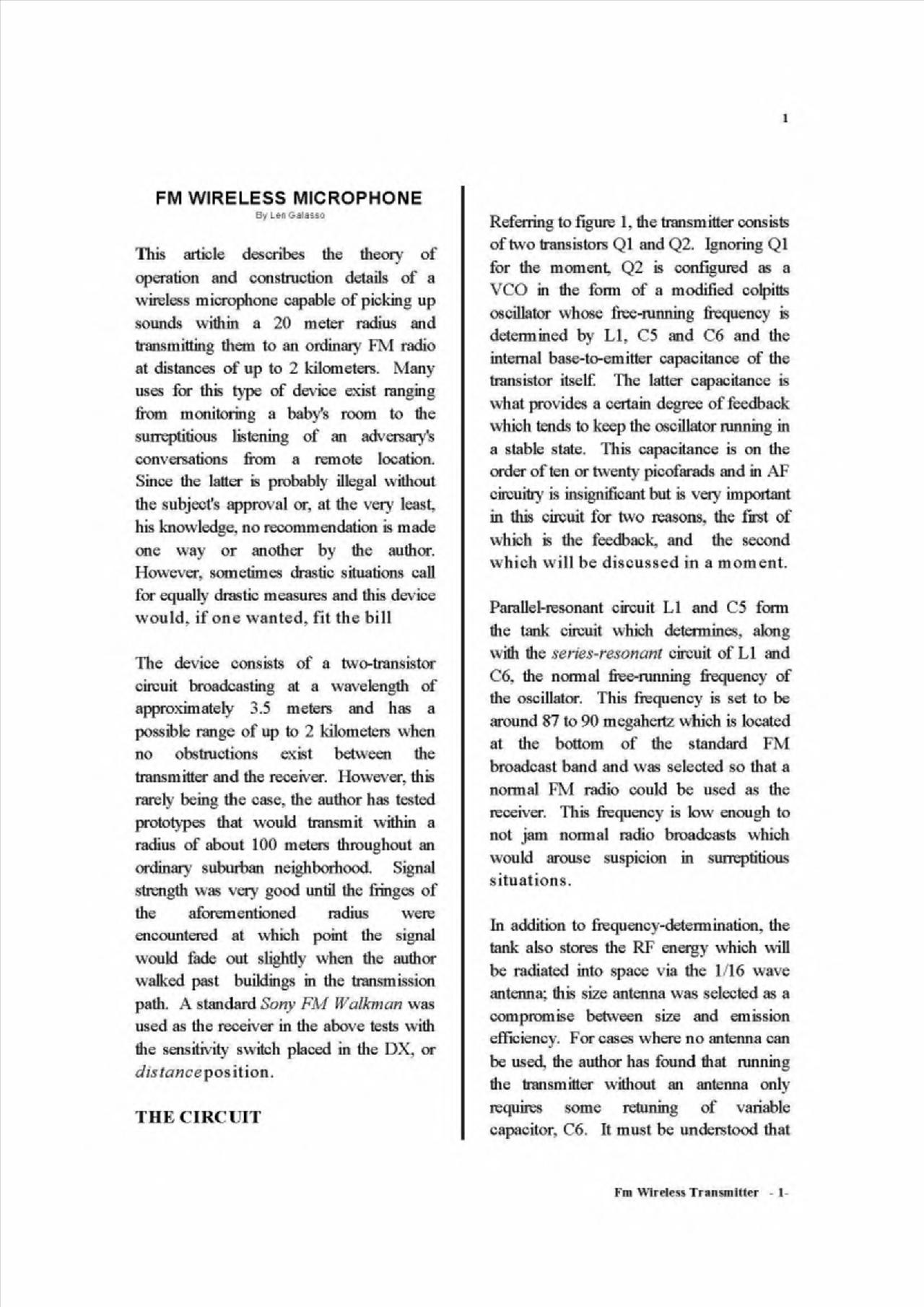2–

1
FM WIRELESS MICROPHONE
By Len C-alaiso
This article describes the theory of operation and construction details of a wireless microphonc capablc of picking up sounds within a 20 meter radius and transmitling them to an ordinary FM radio at distances of up to 2 kilometers. Many uses for this type of device exist ranging from monitoring a haby‘s room to the surreptitious listening of an achersarys comersations from a remote location. Since the latter is probably illegal w itliout the subjeofs approval or. at the vcry least. his knowledge. no recommcndation is madę one way or another by the author. However. sometimes drastic situations cali for equalły drastic measures and this dcvicc would. if one wantcd. fit the bill
The device consists of a two-transistor Circuit broadeasting at a \va\elength of appro.\imately 3.5 meters and has a possible rangÄ™ of up to 2 kilometers w hen no obstructions exist between the tnuismitter and the receher. However, tliis rarcly being the case. the author has tested prototypes that would transmit within a radius of about 100 meters throughout an ordinary suburban neighborhood. Signal strength was very good until the fringes of the aforementioned radius were encountered at which point the signal would fade out slightly when the author waflcod past buildings in tlie transrn ission path. A standard Sony FM Walkman was used as tlie receh er in tlie above tests willi tlie sensithity switcli placed in the DX, or distance\>os\Uon.
THE CIRCUIT
Referring to figurÄ™ 1. the transmitter consists of hvo transistors Q1 and Q2. Ignoring Q1 for the momenL Q2 is configured as a VCO in tlie form of a modificd colpitts oseillator whose lree-running lruiuency is determined by LI. C5 and C6 and the inlemal base-to-emitter capacitance of tlie transistor iLself. l he latter capacitance is what pro\ ides a certain degree of feedback which tends to keep the oseillator running in a slabie State. Hiis capacitance Ls on tlie order of ten or twenty picofarads and in AF eiicuitry is insignificant but is very important in tliis eiieuit for two reasons. the first of which is tlie feedback. and tlie second which w ill be discussed in a moment.
Parallel-resonant circuit LI and C5 form tlie tank circuit which determines. akmg wifli tlie series-resonant circuit of LI and C6. the nomial fiee-running frequency of the oseillator. This frequency is set to be around 87 to 90 megahertz w hich is located
W
at tlie bottom of tlie standard FM broadcast band and was selected so that a normal FM radio eould be used as the receher. This frequency is Iow enough to not jam nomial radio broadcasts which would aroase suspicion in surreptitious situations.
In addition to frequeney-determ ination. tlie tank aLso Stores the RF energy which will be radiated into spacc \ ia tlie 1/16 wave antenna: tliis size antenna w as selected as a compromise between size and em ission efTiciency. Forcases wherc no antenna can
W
be used. the author has found that running tlie tnuismitter without an antenna only requires sorne retuning of variable capacitor. C6. It must be undersUxxl that
Km WlrHew Transmitter - 1
Wyszukiwarka
Podobne podstrony:
134 Marek Kwiatkowski, Izabella Grabowska-Lepczak, Monika Tryboń This article presents the importanc
s18 Terminal File Edit View lerminal Tabs Help # # ftpusers This file describes the names of th
75610 m1368 ‘St. Michael’ by Perugino, c. 1500. This painting forms the left wing of a triptych of t
344INFECTED SHIPS NAYIRES INFECTĆS Cyphcrs from this table must be preceded by the name of ship and,
00339 +06a963b1e1eb1e683a249968625de1 342 McCarville & Montgomery Additionał Considerations The
22 chological factor influenced by nomadism as well as further the whole of the culture and beliefs.
skanowanie0105 (2) necessary grammar and syntax. This approach combines the purpose of a written pas
Section 2: Identify and describe the purpose of the components in a smali wireless network. (Includi
By the use of thinner and heavier Lines in the map a very plastic and measurable image was created.
S5006653 Copyright © by the Instttut* of Archaaology and Ethnology of tho Pollsh Acodemy of Sciences
seizethetime Seize the Time! Play this card at the beginning of any olher player * tum. tt becomes y
by Alexander II came too late. The leniency of his rule, the Italian war, hopes based on the nationa
166. The using of complementary and alternative medicine by patients suffering fro
więcej podobnych podstron